Managerial Accounting Systems in Contemporary Organizations - HI5017
VerifiedAdded on 2022/11/19
|11
|4580
|151
Report
AI Summary
This report critically analyzes two journal articles regarding the application and relevance of managerial accounting systems (MAS) in contemporary companies, focusing on their impact on managerial decision-making and the achievement of business objectives. The report begins with an abstract that outlines the role of managerial accounting in assisting decision-making through data collection, management, and communication. It identifies and explains various management accounting methods and techniques, including Activity-Based Costing (ABC), Total Quality Management (TQM), and Just-In-Time (JIT) inventory. The report then assesses the relevance of MAS to contemporary organizations, supported by evidence from a case study company, and compares these findings with those of another journal article. The comparison highlights both similarities and differences in the findings regarding the practical application and effectiveness of MAS. The report also discusses the outcomes and lessons learned from the research findings that will be useful for management accountants in Australian companies, offering insights into the challenges and benefits of implementing contemporary MAS techniques.
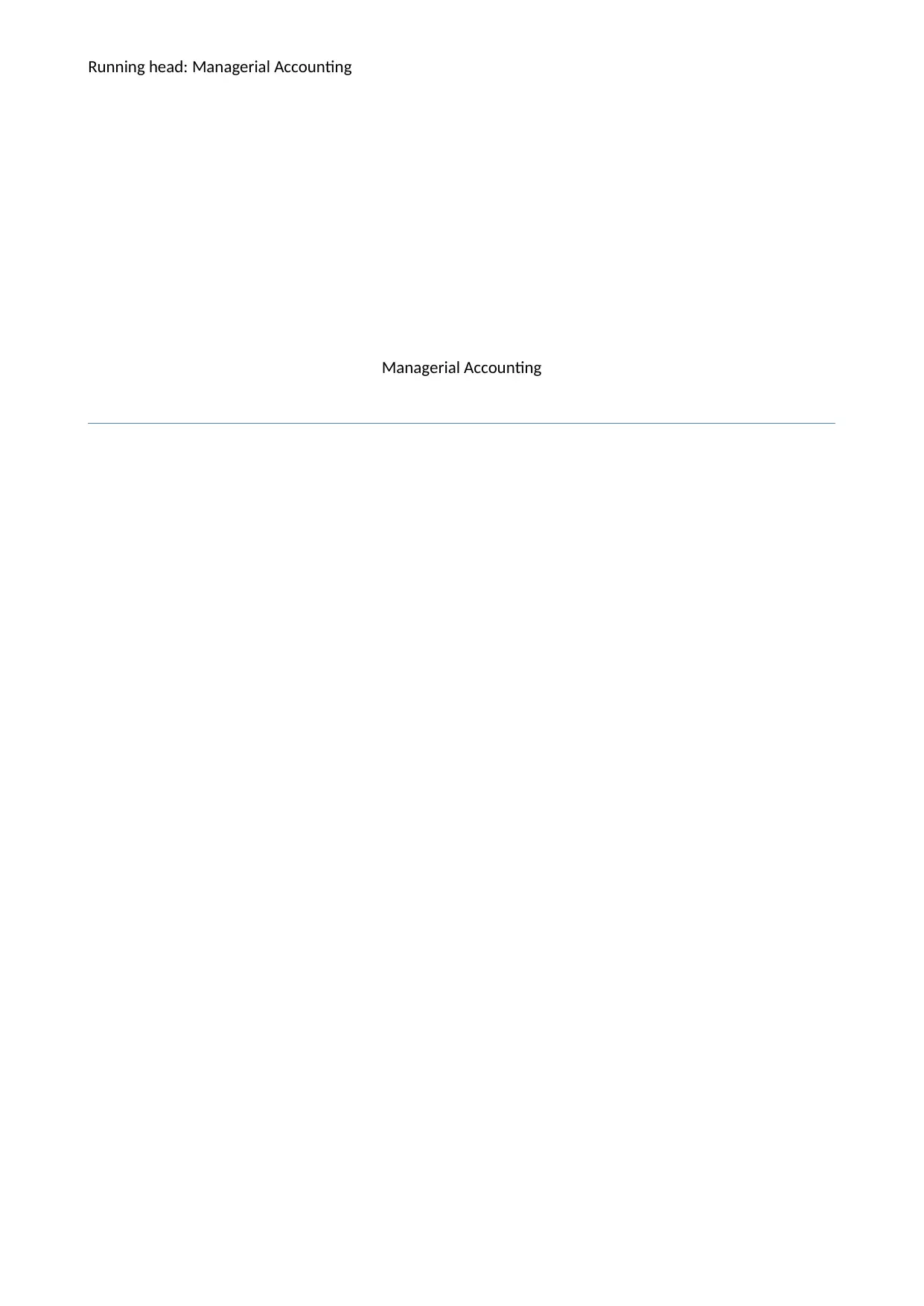
Running head: Managerial Accounting
Managerial Accounting
Managerial Accounting
Paraphrase This Document
Need a fresh take? Get an instant paraphrase of this document with our AI Paraphraser
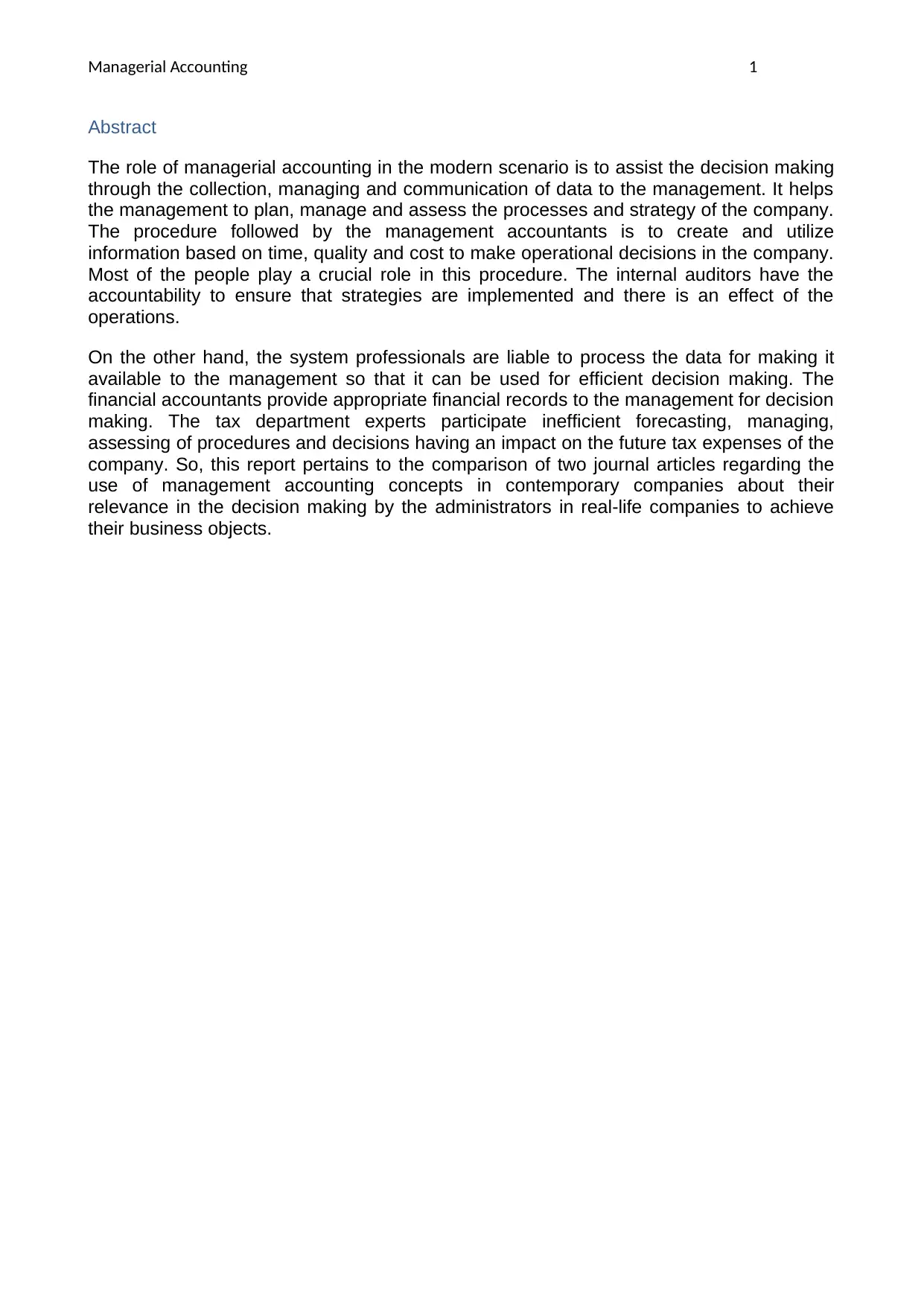
Managerial Accounting 1
Abstract
The role of managerial accounting in the modern scenario is to assist the decision making
through the collection, managing and communication of data to the management. It helps
the management to plan, manage and assess the processes and strategy of the company.
The procedure followed by the management accountants is to create and utilize
information based on time, quality and cost to make operational decisions in the company.
Most of the people play a crucial role in this procedure. The internal auditors have the
accountability to ensure that strategies are implemented and there is an effect of the
operations.
On the other hand, the system professionals are liable to process the data for making it
available to the management so that it can be used for efficient decision making. The
financial accountants provide appropriate financial records to the management for decision
making. The tax department experts participate inefficient forecasting, managing,
assessing of procedures and decisions having an impact on the future tax expenses of the
company. So, this report pertains to the comparison of two journal articles regarding the
use of management accounting concepts in contemporary companies about their
relevance in the decision making by the administrators in real-life companies to achieve
their business objects.
Abstract
The role of managerial accounting in the modern scenario is to assist the decision making
through the collection, managing and communication of data to the management. It helps
the management to plan, manage and assess the processes and strategy of the company.
The procedure followed by the management accountants is to create and utilize
information based on time, quality and cost to make operational decisions in the company.
Most of the people play a crucial role in this procedure. The internal auditors have the
accountability to ensure that strategies are implemented and there is an effect of the
operations.
On the other hand, the system professionals are liable to process the data for making it
available to the management so that it can be used for efficient decision making. The
financial accountants provide appropriate financial records to the management for decision
making. The tax department experts participate inefficient forecasting, managing,
assessing of procedures and decisions having an impact on the future tax expenses of the
company. So, this report pertains to the comparison of two journal articles regarding the
use of management accounting concepts in contemporary companies about their
relevance in the decision making by the administrators in real-life companies to achieve
their business objects.
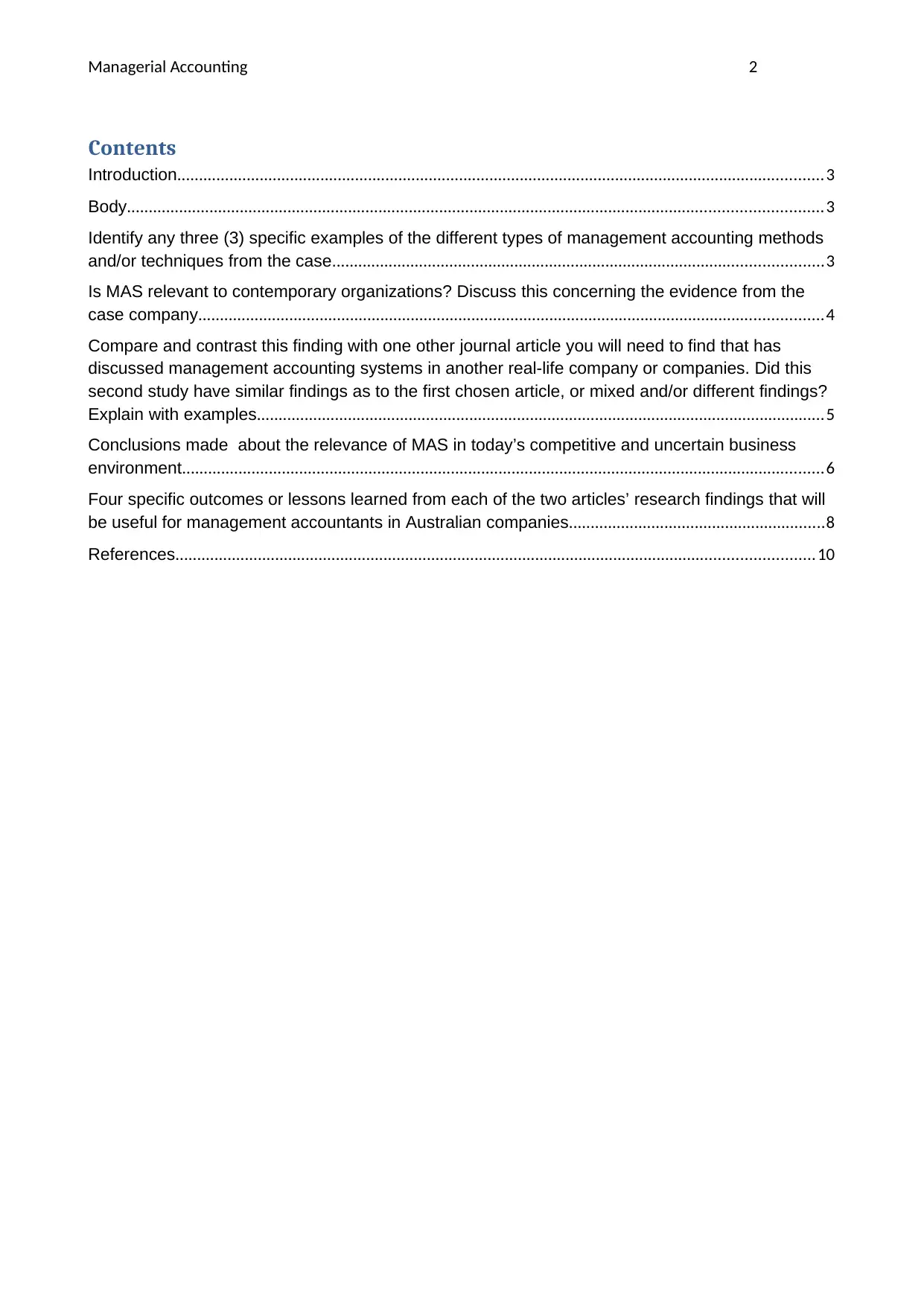
Managerial Accounting 2
Contents
Introduction.....................................................................................................................................................3
Body................................................................................................................................................................3
Identify any three (3) specific examples of the different types of management accounting methods
and/or techniques from the case.................................................................................................................3
Is MAS relevant to contemporary organizations? Discuss this concerning the evidence from the
case company................................................................................................................................................4
Compare and contrast this finding with one other journal article you will need to find that has
discussed management accounting systems in another real-life company or companies. Did this
second study have similar findings as to the first chosen article, or mixed and/or different findings?
Explain with examples...................................................................................................................................5
Conclusions made about the relevance of MAS in today’s competitive and uncertain business
environment....................................................................................................................................................6
Four specific outcomes or lessons learned from each of the two articles’ research findings that will
be useful for management accountants in Australian companies...........................................................8
References...................................................................................................................................................10
Contents
Introduction.....................................................................................................................................................3
Body................................................................................................................................................................3
Identify any three (3) specific examples of the different types of management accounting methods
and/or techniques from the case.................................................................................................................3
Is MAS relevant to contemporary organizations? Discuss this concerning the evidence from the
case company................................................................................................................................................4
Compare and contrast this finding with one other journal article you will need to find that has
discussed management accounting systems in another real-life company or companies. Did this
second study have similar findings as to the first chosen article, or mixed and/or different findings?
Explain with examples...................................................................................................................................5
Conclusions made about the relevance of MAS in today’s competitive and uncertain business
environment....................................................................................................................................................6
Four specific outcomes or lessons learned from each of the two articles’ research findings that will
be useful for management accountants in Australian companies...........................................................8
References...................................................................................................................................................10
⊘ This is a preview!⊘
Do you want full access?
Subscribe today to unlock all pages.

Trusted by 1+ million students worldwide
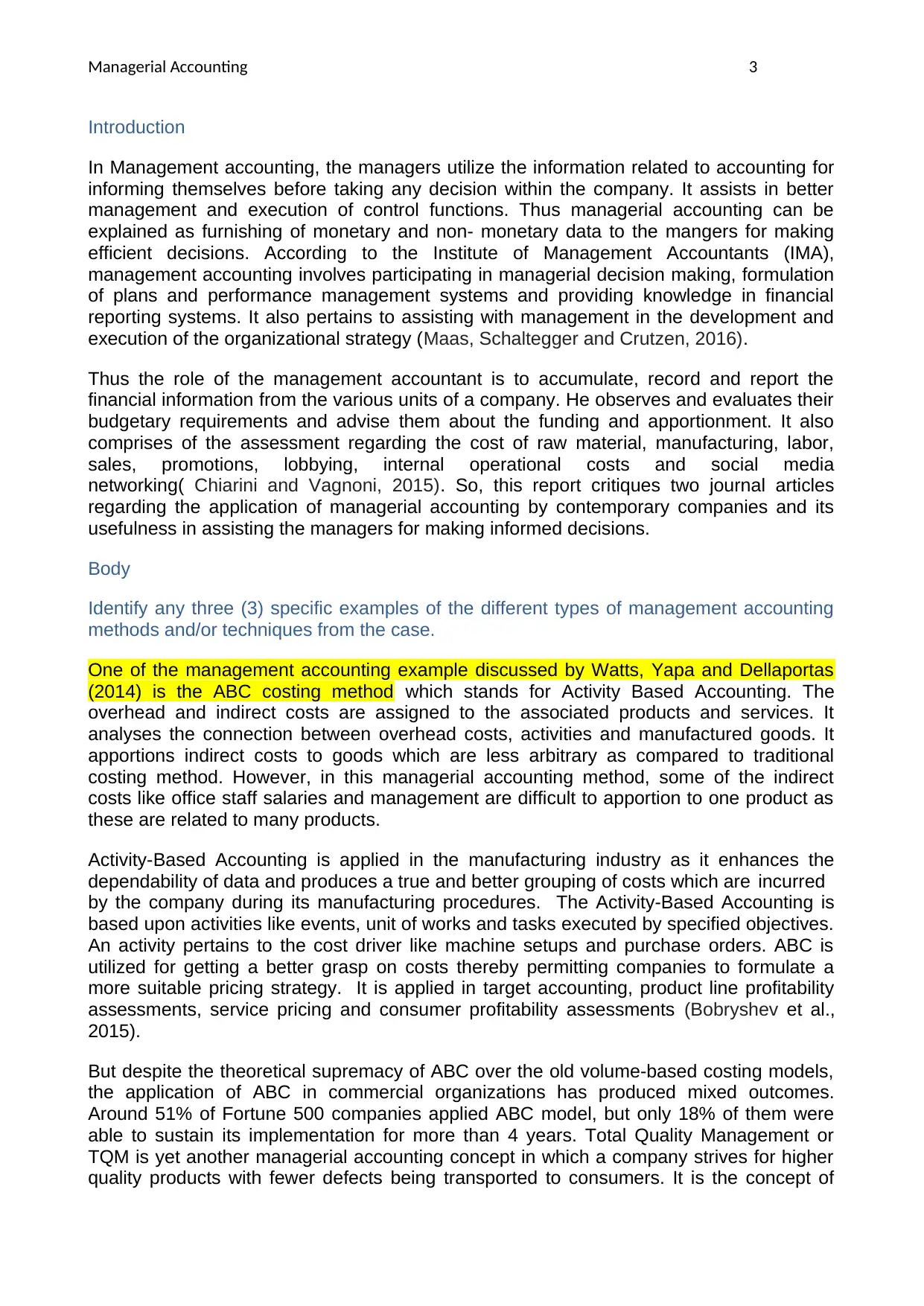
Managerial Accounting 3
Introduction
In Management accounting, the managers utilize the information related to accounting for
informing themselves before taking any decision within the company. It assists in better
management and execution of control functions. Thus managerial accounting can be
explained as furnishing of monetary and non- monetary data to the mangers for making
efficient decisions. According to the Institute of Management Accountants (IMA),
management accounting involves participating in managerial decision making, formulation
of plans and performance management systems and providing knowledge in financial
reporting systems. It also pertains to assisting with management in the development and
execution of the organizational strategy (Maas, Schaltegger and Crutzen, 2016).
Thus the role of the management accountant is to accumulate, record and report the
financial information from the various units of a company. He observes and evaluates their
budgetary requirements and advise them about the funding and apportionment. It also
comprises of the assessment regarding the cost of raw material, manufacturing, labor,
sales, promotions, lobbying, internal operational costs and social media
networking( Chiarini and Vagnoni, 2015). So, this report critiques two journal articles
regarding the application of managerial accounting by contemporary companies and its
usefulness in assisting the managers for making informed decisions.
Body
Identify any three (3) specific examples of the different types of management accounting
methods and/or techniques from the case.
One of the management accounting example discussed by Watts, Yapa and Dellaportas
(2014) is the ABC costing method which stands for Activity Based Accounting. The
overhead and indirect costs are assigned to the associated products and services. It
analyses the connection between overhead costs, activities and manufactured goods. It
apportions indirect costs to goods which are less arbitrary as compared to traditional
costing method. However, in this managerial accounting method, some of the indirect
costs like office staff salaries and management are difficult to apportion to one product as
these are related to many products.
Activity-Based Accounting is applied in the manufacturing industry as it enhances the
dependability of data and produces a true and better grouping of costs which are incurred
by the company during its manufacturing procedures. The Activity-Based Accounting is
based upon activities like events, unit of works and tasks executed by specified objectives.
An activity pertains to the cost driver like machine setups and purchase orders. ABC is
utilized for getting a better grasp on costs thereby permitting companies to formulate a
more suitable pricing strategy. It is applied in target accounting, product line profitability
assessments, service pricing and consumer profitability assessments (Bobryshev et al.,
2015).
But despite the theoretical supremacy of ABC over the old volume-based costing models,
the application of ABC in commercial organizations has produced mixed outcomes.
Around 51% of Fortune 500 companies applied ABC model, but only 18% of them were
able to sustain its implementation for more than 4 years. Total Quality Management or
TQM is yet another managerial accounting concept in which a company strives for higher
quality products with fewer defects being transported to consumers. It is the concept of
Introduction
In Management accounting, the managers utilize the information related to accounting for
informing themselves before taking any decision within the company. It assists in better
management and execution of control functions. Thus managerial accounting can be
explained as furnishing of monetary and non- monetary data to the mangers for making
efficient decisions. According to the Institute of Management Accountants (IMA),
management accounting involves participating in managerial decision making, formulation
of plans and performance management systems and providing knowledge in financial
reporting systems. It also pertains to assisting with management in the development and
execution of the organizational strategy (Maas, Schaltegger and Crutzen, 2016).
Thus the role of the management accountant is to accumulate, record and report the
financial information from the various units of a company. He observes and evaluates their
budgetary requirements and advise them about the funding and apportionment. It also
comprises of the assessment regarding the cost of raw material, manufacturing, labor,
sales, promotions, lobbying, internal operational costs and social media
networking( Chiarini and Vagnoni, 2015). So, this report critiques two journal articles
regarding the application of managerial accounting by contemporary companies and its
usefulness in assisting the managers for making informed decisions.
Body
Identify any three (3) specific examples of the different types of management accounting
methods and/or techniques from the case.
One of the management accounting example discussed by Watts, Yapa and Dellaportas
(2014) is the ABC costing method which stands for Activity Based Accounting. The
overhead and indirect costs are assigned to the associated products and services. It
analyses the connection between overhead costs, activities and manufactured goods. It
apportions indirect costs to goods which are less arbitrary as compared to traditional
costing method. However, in this managerial accounting method, some of the indirect
costs like office staff salaries and management are difficult to apportion to one product as
these are related to many products.
Activity-Based Accounting is applied in the manufacturing industry as it enhances the
dependability of data and produces a true and better grouping of costs which are incurred
by the company during its manufacturing procedures. The Activity-Based Accounting is
based upon activities like events, unit of works and tasks executed by specified objectives.
An activity pertains to the cost driver like machine setups and purchase orders. ABC is
utilized for getting a better grasp on costs thereby permitting companies to formulate a
more suitable pricing strategy. It is applied in target accounting, product line profitability
assessments, service pricing and consumer profitability assessments (Bobryshev et al.,
2015).
But despite the theoretical supremacy of ABC over the old volume-based costing models,
the application of ABC in commercial organizations has produced mixed outcomes.
Around 51% of Fortune 500 companies applied ABC model, but only 18% of them were
able to sustain its implementation for more than 4 years. Total Quality Management or
TQM is yet another managerial accounting concept in which a company strives for higher
quality products with fewer defects being transported to consumers. It is the concept of
Paraphrase This Document
Need a fresh take? Get an instant paraphrase of this document with our AI Paraphraser
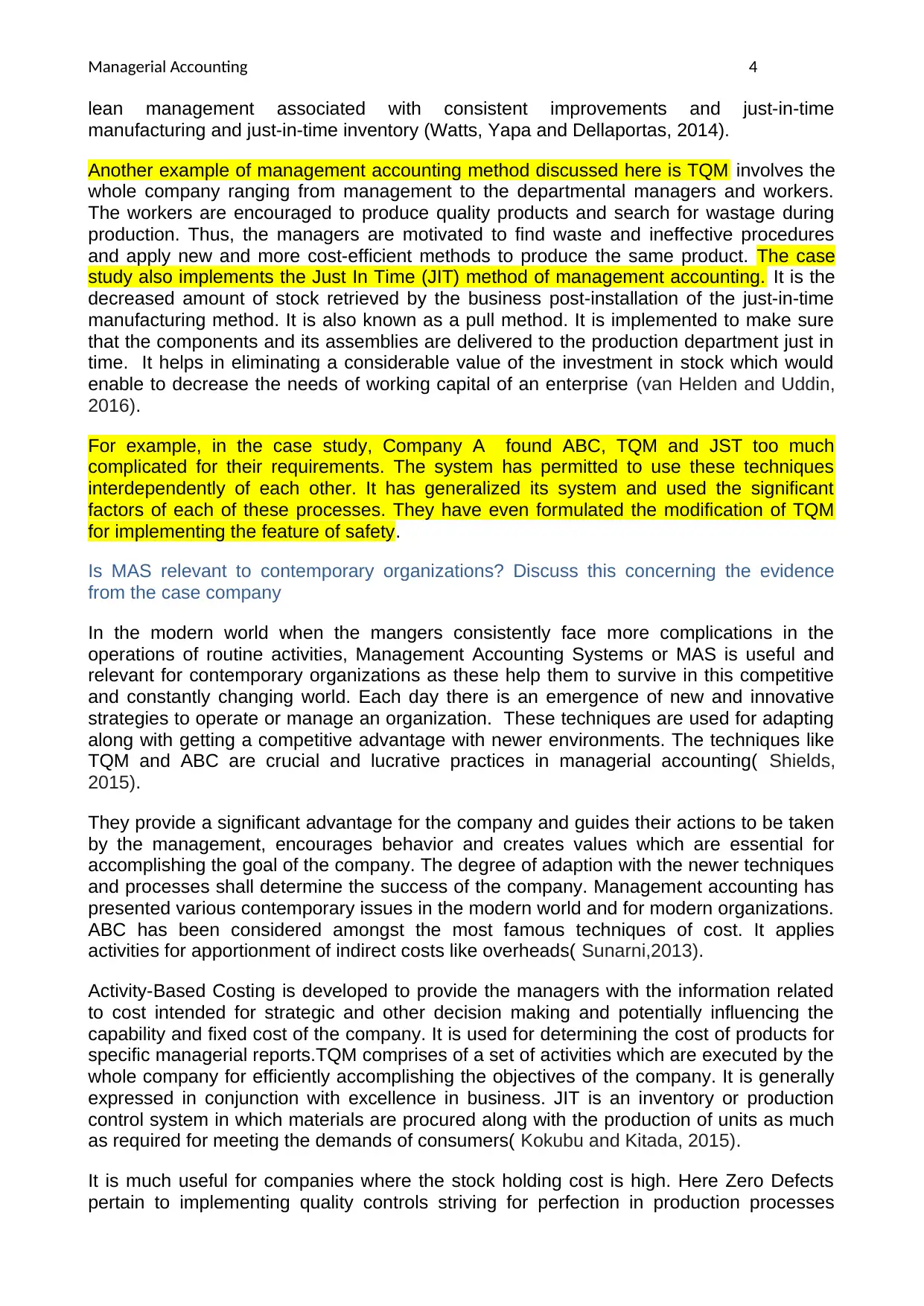
Managerial Accounting 4
lean management associated with consistent improvements and just-in-time
manufacturing and just-in-time inventory (Watts, Yapa and Dellaportas, 2014).
Another example of management accounting method discussed here is TQM involves the
whole company ranging from management to the departmental managers and workers.
The workers are encouraged to produce quality products and search for wastage during
production. Thus, the managers are motivated to find waste and ineffective procedures
and apply new and more cost-efficient methods to produce the same product. The case
study also implements the Just In Time (JIT) method of management accounting. It is the
decreased amount of stock retrieved by the business post-installation of the just-in-time
manufacturing method. It is also known as a pull method. It is implemented to make sure
that the components and its assemblies are delivered to the production department just in
time. It helps in eliminating a considerable value of the investment in stock which would
enable to decrease the needs of working capital of an enterprise (van Helden and Uddin,
2016).
For example, in the case study, Company A found ABC, TQM and JST too much
complicated for their requirements. The system has permitted to use these techniques
interdependently of each other. It has generalized its system and used the significant
factors of each of these processes. They have even formulated the modification of TQM
for implementing the feature of safety.
Is MAS relevant to contemporary organizations? Discuss this concerning the evidence
from the case company
In the modern world when the mangers consistently face more complications in the
operations of routine activities, Management Accounting Systems or MAS is useful and
relevant for contemporary organizations as these help them to survive in this competitive
and constantly changing world. Each day there is an emergence of new and innovative
strategies to operate or manage an organization. These techniques are used for adapting
along with getting a competitive advantage with newer environments. The techniques like
TQM and ABC are crucial and lucrative practices in managerial accounting( Shields,
2015).
They provide a significant advantage for the company and guides their actions to be taken
by the management, encourages behavior and creates values which are essential for
accomplishing the goal of the company. The degree of adaption with the newer techniques
and processes shall determine the success of the company. Management accounting has
presented various contemporary issues in the modern world and for modern organizations.
ABC has been considered amongst the most famous techniques of cost. It applies
activities for apportionment of indirect costs like overheads( Sunarni,2013).
Activity-Based Costing is developed to provide the managers with the information related
to cost intended for strategic and other decision making and potentially influencing the
capability and fixed cost of the company. It is used for determining the cost of products for
specific managerial reports.TQM comprises of a set of activities which are executed by the
whole company for efficiently accomplishing the objectives of the company. It is generally
expressed in conjunction with excellence in business. JIT is an inventory or production
control system in which materials are procured along with the production of units as much
as required for meeting the demands of consumers( Kokubu and Kitada, 2015).
It is much useful for companies where the stock holding cost is high. Here Zero Defects
pertain to implementing quality controls striving for perfection in production processes
lean management associated with consistent improvements and just-in-time
manufacturing and just-in-time inventory (Watts, Yapa and Dellaportas, 2014).
Another example of management accounting method discussed here is TQM involves the
whole company ranging from management to the departmental managers and workers.
The workers are encouraged to produce quality products and search for wastage during
production. Thus, the managers are motivated to find waste and ineffective procedures
and apply new and more cost-efficient methods to produce the same product. The case
study also implements the Just In Time (JIT) method of management accounting. It is the
decreased amount of stock retrieved by the business post-installation of the just-in-time
manufacturing method. It is also known as a pull method. It is implemented to make sure
that the components and its assemblies are delivered to the production department just in
time. It helps in eliminating a considerable value of the investment in stock which would
enable to decrease the needs of working capital of an enterprise (van Helden and Uddin,
2016).
For example, in the case study, Company A found ABC, TQM and JST too much
complicated for their requirements. The system has permitted to use these techniques
interdependently of each other. It has generalized its system and used the significant
factors of each of these processes. They have even formulated the modification of TQM
for implementing the feature of safety.
Is MAS relevant to contemporary organizations? Discuss this concerning the evidence
from the case company
In the modern world when the mangers consistently face more complications in the
operations of routine activities, Management Accounting Systems or MAS is useful and
relevant for contemporary organizations as these help them to survive in this competitive
and constantly changing world. Each day there is an emergence of new and innovative
strategies to operate or manage an organization. These techniques are used for adapting
along with getting a competitive advantage with newer environments. The techniques like
TQM and ABC are crucial and lucrative practices in managerial accounting( Shields,
2015).
They provide a significant advantage for the company and guides their actions to be taken
by the management, encourages behavior and creates values which are essential for
accomplishing the goal of the company. The degree of adaption with the newer techniques
and processes shall determine the success of the company. Management accounting has
presented various contemporary issues in the modern world and for modern organizations.
ABC has been considered amongst the most famous techniques of cost. It applies
activities for apportionment of indirect costs like overheads( Sunarni,2013).
Activity-Based Costing is developed to provide the managers with the information related
to cost intended for strategic and other decision making and potentially influencing the
capability and fixed cost of the company. It is used for determining the cost of products for
specific managerial reports.TQM comprises of a set of activities which are executed by the
whole company for efficiently accomplishing the objectives of the company. It is generally
expressed in conjunction with excellence in business. JIT is an inventory or production
control system in which materials are procured along with the production of units as much
as required for meeting the demands of consumers( Kokubu and Kitada, 2015).
It is much useful for companies where the stock holding cost is high. Here Zero Defects
pertain to implementing quality controls striving for perfection in production processes
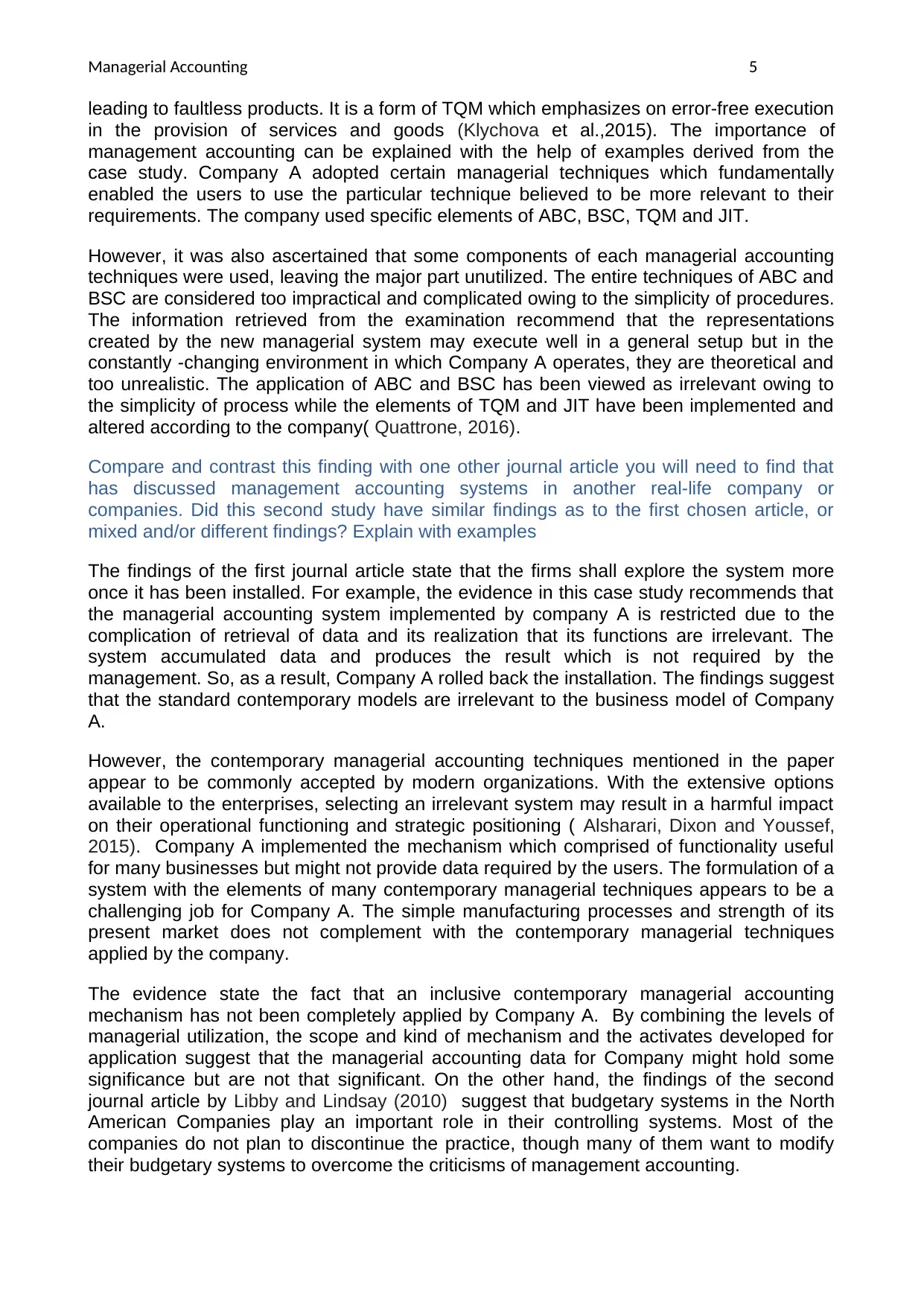
Managerial Accounting 5
leading to faultless products. It is a form of TQM which emphasizes on error-free execution
in the provision of services and goods (Klychova et al.,2015). The importance of
management accounting can be explained with the help of examples derived from the
case study. Company A adopted certain managerial techniques which fundamentally
enabled the users to use the particular technique believed to be more relevant to their
requirements. The company used specific elements of ABC, BSC, TQM and JIT.
However, it was also ascertained that some components of each managerial accounting
techniques were used, leaving the major part unutilized. The entire techniques of ABC and
BSC are considered too impractical and complicated owing to the simplicity of procedures.
The information retrieved from the examination recommend that the representations
created by the new managerial system may execute well in a general setup but in the
constantly -changing environment in which Company A operates, they are theoretical and
too unrealistic. The application of ABC and BSC has been viewed as irrelevant owing to
the simplicity of process while the elements of TQM and JIT have been implemented and
altered according to the company( Quattrone, 2016).
Compare and contrast this finding with one other journal article you will need to find that
has discussed management accounting systems in another real-life company or
companies. Did this second study have similar findings as to the first chosen article, or
mixed and/or different findings? Explain with examples
The findings of the first journal article state that the firms shall explore the system more
once it has been installed. For example, the evidence in this case study recommends that
the managerial accounting system implemented by company A is restricted due to the
complication of retrieval of data and its realization that its functions are irrelevant. The
system accumulated data and produces the result which is not required by the
management. So, as a result, Company A rolled back the installation. The findings suggest
that the standard contemporary models are irrelevant to the business model of Company
A.
However, the contemporary managerial accounting techniques mentioned in the paper
appear to be commonly accepted by modern organizations. With the extensive options
available to the enterprises, selecting an irrelevant system may result in a harmful impact
on their operational functioning and strategic positioning ( Alsharari, Dixon and Youssef,
2015). Company A implemented the mechanism which comprised of functionality useful
for many businesses but might not provide data required by the users. The formulation of a
system with the elements of many contemporary managerial techniques appears to be a
challenging job for Company A. The simple manufacturing processes and strength of its
present market does not complement with the contemporary managerial techniques
applied by the company.
The evidence state the fact that an inclusive contemporary managerial accounting
mechanism has not been completely applied by Company A. By combining the levels of
managerial utilization, the scope and kind of mechanism and the activates developed for
application suggest that the managerial accounting data for Company might hold some
significance but are not that significant. On the other hand, the findings of the second
journal article by Libby and Lindsay (2010) suggest that budgetary systems in the North
American Companies play an important role in their controlling systems. Most of the
companies do not plan to discontinue the practice, though many of them want to modify
their budgetary systems to overcome the criticisms of management accounting.
leading to faultless products. It is a form of TQM which emphasizes on error-free execution
in the provision of services and goods (Klychova et al.,2015). The importance of
management accounting can be explained with the help of examples derived from the
case study. Company A adopted certain managerial techniques which fundamentally
enabled the users to use the particular technique believed to be more relevant to their
requirements. The company used specific elements of ABC, BSC, TQM and JIT.
However, it was also ascertained that some components of each managerial accounting
techniques were used, leaving the major part unutilized. The entire techniques of ABC and
BSC are considered too impractical and complicated owing to the simplicity of procedures.
The information retrieved from the examination recommend that the representations
created by the new managerial system may execute well in a general setup but in the
constantly -changing environment in which Company A operates, they are theoretical and
too unrealistic. The application of ABC and BSC has been viewed as irrelevant owing to
the simplicity of process while the elements of TQM and JIT have been implemented and
altered according to the company( Quattrone, 2016).
Compare and contrast this finding with one other journal article you will need to find that
has discussed management accounting systems in another real-life company or
companies. Did this second study have similar findings as to the first chosen article, or
mixed and/or different findings? Explain with examples
The findings of the first journal article state that the firms shall explore the system more
once it has been installed. For example, the evidence in this case study recommends that
the managerial accounting system implemented by company A is restricted due to the
complication of retrieval of data and its realization that its functions are irrelevant. The
system accumulated data and produces the result which is not required by the
management. So, as a result, Company A rolled back the installation. The findings suggest
that the standard contemporary models are irrelevant to the business model of Company
A.
However, the contemporary managerial accounting techniques mentioned in the paper
appear to be commonly accepted by modern organizations. With the extensive options
available to the enterprises, selecting an irrelevant system may result in a harmful impact
on their operational functioning and strategic positioning ( Alsharari, Dixon and Youssef,
2015). Company A implemented the mechanism which comprised of functionality useful
for many businesses but might not provide data required by the users. The formulation of a
system with the elements of many contemporary managerial techniques appears to be a
challenging job for Company A. The simple manufacturing processes and strength of its
present market does not complement with the contemporary managerial techniques
applied by the company.
The evidence state the fact that an inclusive contemporary managerial accounting
mechanism has not been completely applied by Company A. By combining the levels of
managerial utilization, the scope and kind of mechanism and the activates developed for
application suggest that the managerial accounting data for Company might hold some
significance but are not that significant. On the other hand, the findings of the second
journal article by Libby and Lindsay (2010) suggest that budgetary systems in the North
American Companies play an important role in their controlling systems. Most of the
companies do not plan to discontinue the practice, though many of them want to modify
their budgetary systems to overcome the criticisms of management accounting.
⊘ This is a preview!⊘
Do you want full access?
Subscribe today to unlock all pages.

Trusted by 1+ million students worldwide
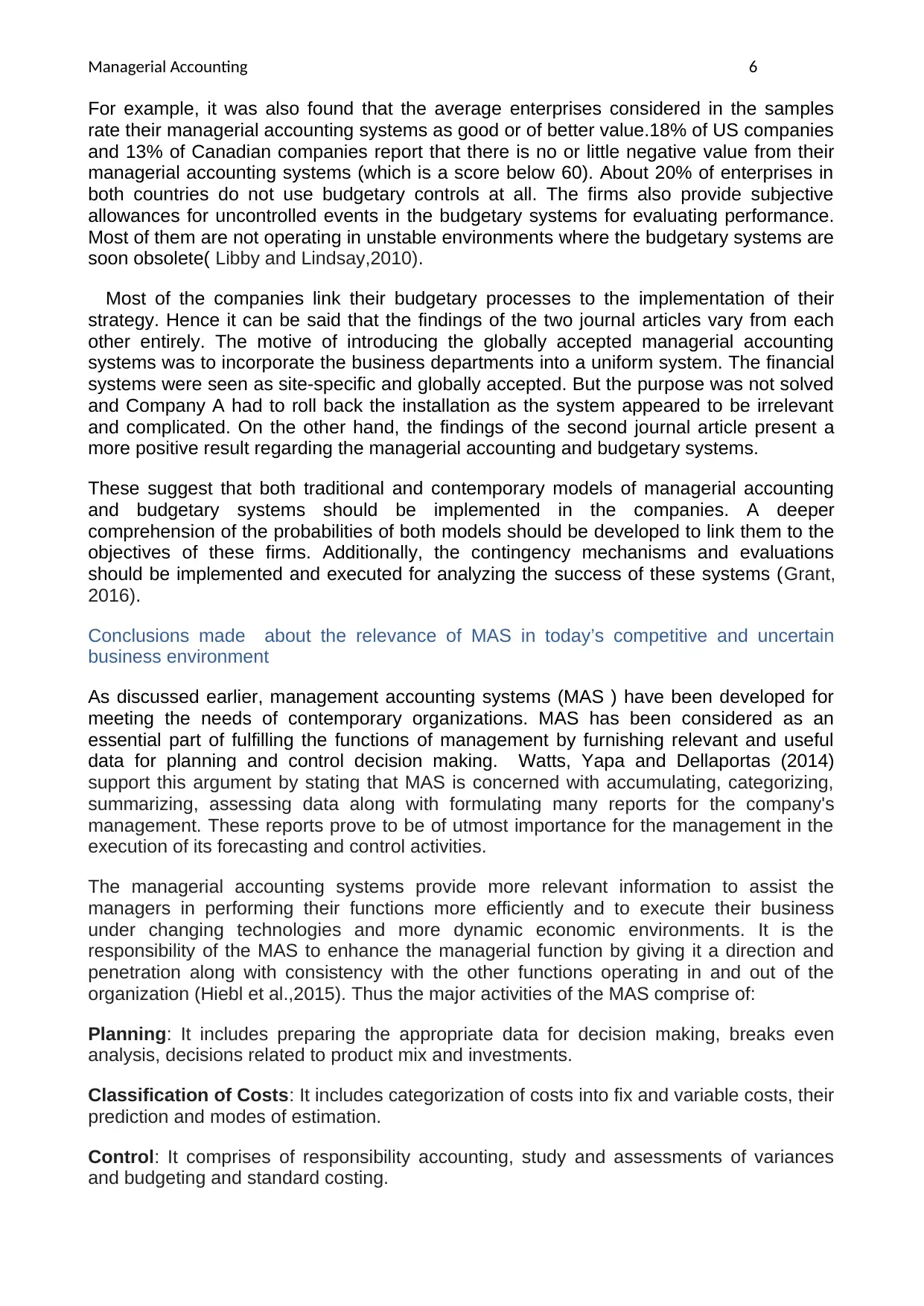
Managerial Accounting 6
For example, it was also found that the average enterprises considered in the samples
rate their managerial accounting systems as good or of better value.18% of US companies
and 13% of Canadian companies report that there is no or little negative value from their
managerial accounting systems (which is a score below 60). About 20% of enterprises in
both countries do not use budgetary controls at all. The firms also provide subjective
allowances for uncontrolled events in the budgetary systems for evaluating performance.
Most of them are not operating in unstable environments where the budgetary systems are
soon obsolete( Libby and Lindsay,2010).
Most of the companies link their budgetary processes to the implementation of their
strategy. Hence it can be said that the findings of the two journal articles vary from each
other entirely. The motive of introducing the globally accepted managerial accounting
systems was to incorporate the business departments into a uniform system. The financial
systems were seen as site-specific and globally accepted. But the purpose was not solved
and Company A had to roll back the installation as the system appeared to be irrelevant
and complicated. On the other hand, the findings of the second journal article present a
more positive result regarding the managerial accounting and budgetary systems.
These suggest that both traditional and contemporary models of managerial accounting
and budgetary systems should be implemented in the companies. A deeper
comprehension of the probabilities of both models should be developed to link them to the
objectives of these firms. Additionally, the contingency mechanisms and evaluations
should be implemented and executed for analyzing the success of these systems (Grant,
2016).
Conclusions made about the relevance of MAS in today’s competitive and uncertain
business environment
As discussed earlier, management accounting systems (MAS ) have been developed for
meeting the needs of contemporary organizations. MAS has been considered as an
essential part of fulfilling the functions of management by furnishing relevant and useful
data for planning and control decision making. Watts, Yapa and Dellaportas (2014)
support this argument by stating that MAS is concerned with accumulating, categorizing,
summarizing, assessing data along with formulating many reports for the company's
management. These reports prove to be of utmost importance for the management in the
execution of its forecasting and control activities.
The managerial accounting systems provide more relevant information to assist the
managers in performing their functions more efficiently and to execute their business
under changing technologies and more dynamic economic environments. It is the
responsibility of the MAS to enhance the managerial function by giving it a direction and
penetration along with consistency with the other functions operating in and out of the
organization (Hiebl et al.,2015). Thus the major activities of the MAS comprise of:
Planning: It includes preparing the appropriate data for decision making, breaks even
analysis, decisions related to product mix and investments.
Classification of Costs: It includes categorization of costs into fix and variable costs, their
prediction and modes of estimation.
Control: It comprises of responsibility accounting, study and assessments of variances
and budgeting and standard costing.
For example, it was also found that the average enterprises considered in the samples
rate their managerial accounting systems as good or of better value.18% of US companies
and 13% of Canadian companies report that there is no or little negative value from their
managerial accounting systems (which is a score below 60). About 20% of enterprises in
both countries do not use budgetary controls at all. The firms also provide subjective
allowances for uncontrolled events in the budgetary systems for evaluating performance.
Most of them are not operating in unstable environments where the budgetary systems are
soon obsolete( Libby and Lindsay,2010).
Most of the companies link their budgetary processes to the implementation of their
strategy. Hence it can be said that the findings of the two journal articles vary from each
other entirely. The motive of introducing the globally accepted managerial accounting
systems was to incorporate the business departments into a uniform system. The financial
systems were seen as site-specific and globally accepted. But the purpose was not solved
and Company A had to roll back the installation as the system appeared to be irrelevant
and complicated. On the other hand, the findings of the second journal article present a
more positive result regarding the managerial accounting and budgetary systems.
These suggest that both traditional and contemporary models of managerial accounting
and budgetary systems should be implemented in the companies. A deeper
comprehension of the probabilities of both models should be developed to link them to the
objectives of these firms. Additionally, the contingency mechanisms and evaluations
should be implemented and executed for analyzing the success of these systems (Grant,
2016).
Conclusions made about the relevance of MAS in today’s competitive and uncertain
business environment
As discussed earlier, management accounting systems (MAS ) have been developed for
meeting the needs of contemporary organizations. MAS has been considered as an
essential part of fulfilling the functions of management by furnishing relevant and useful
data for planning and control decision making. Watts, Yapa and Dellaportas (2014)
support this argument by stating that MAS is concerned with accumulating, categorizing,
summarizing, assessing data along with formulating many reports for the company's
management. These reports prove to be of utmost importance for the management in the
execution of its forecasting and control activities.
The managerial accounting systems provide more relevant information to assist the
managers in performing their functions more efficiently and to execute their business
under changing technologies and more dynamic economic environments. It is the
responsibility of the MAS to enhance the managerial function by giving it a direction and
penetration along with consistency with the other functions operating in and out of the
organization (Hiebl et al.,2015). Thus the major activities of the MAS comprise of:
Planning: It includes preparing the appropriate data for decision making, breaks even
analysis, decisions related to product mix and investments.
Classification of Costs: It includes categorization of costs into fix and variable costs, their
prediction and modes of estimation.
Control: It comprises of responsibility accounting, study and assessments of variances
and budgeting and standard costing.
Paraphrase This Document
Need a fresh take? Get an instant paraphrase of this document with our AI Paraphraser
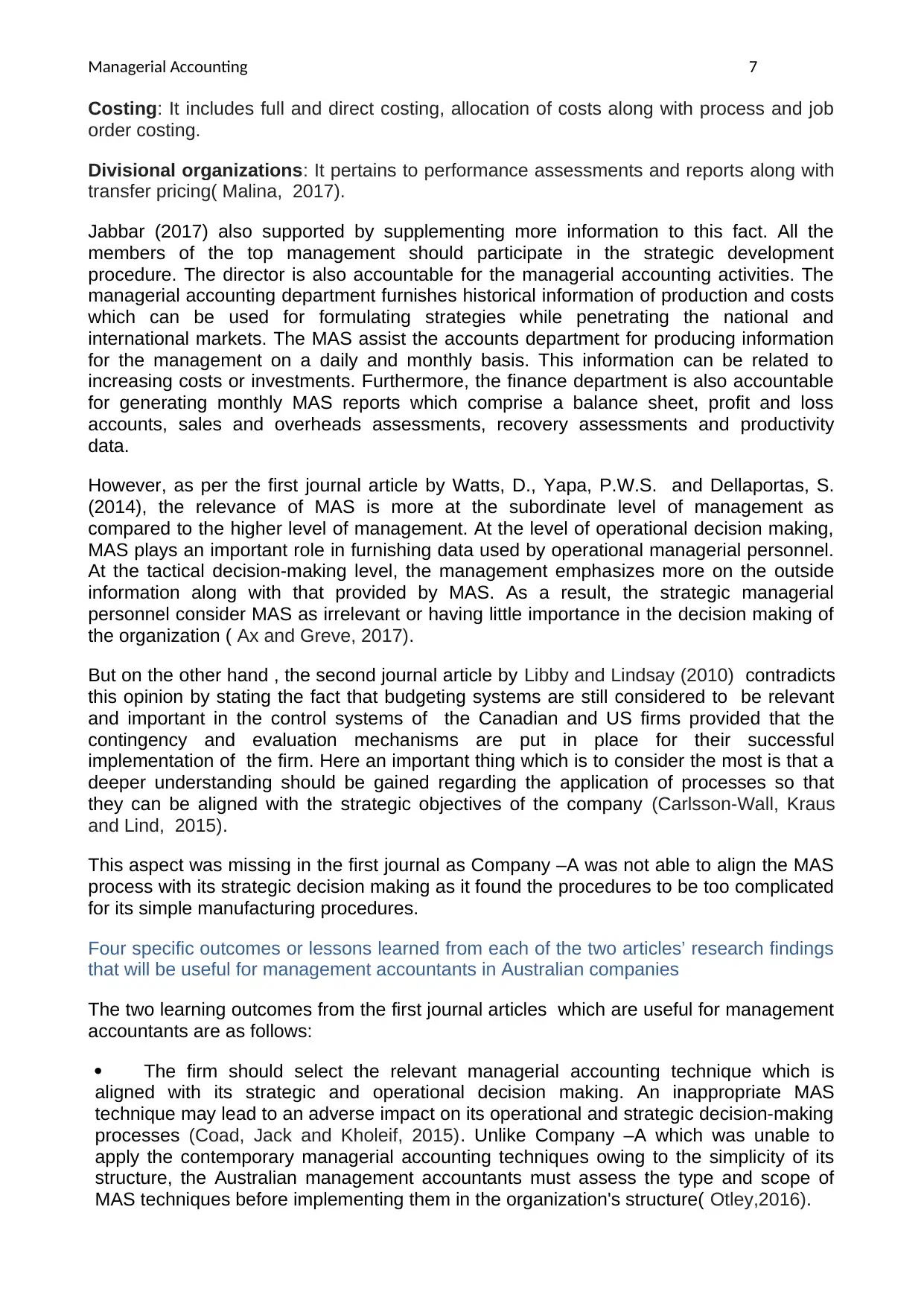
Managerial Accounting 7
Costing: It includes full and direct costing, allocation of costs along with process and job
order costing.
Divisional organizations: It pertains to performance assessments and reports along with
transfer pricing( Malina, 2017).
Jabbar (2017) also supported by supplementing more information to this fact. All the
members of the top management should participate in the strategic development
procedure. The director is also accountable for the managerial accounting activities. The
managerial accounting department furnishes historical information of production and costs
which can be used for formulating strategies while penetrating the national and
international markets. The MAS assist the accounts department for producing information
for the management on a daily and monthly basis. This information can be related to
increasing costs or investments. Furthermore, the finance department is also accountable
for generating monthly MAS reports which comprise a balance sheet, profit and loss
accounts, sales and overheads assessments, recovery assessments and productivity
data.
However, as per the first journal article by Watts, D., Yapa, P.W.S. and Dellaportas, S.
(2014), the relevance of MAS is more at the subordinate level of management as
compared to the higher level of management. At the level of operational decision making,
MAS plays an important role in furnishing data used by operational managerial personnel.
At the tactical decision-making level, the management emphasizes more on the outside
information along with that provided by MAS. As a result, the strategic managerial
personnel consider MAS as irrelevant or having little importance in the decision making of
the organization ( Ax and Greve, 2017).
But on the other hand , the second journal article by Libby and Lindsay (2010) contradicts
this opinion by stating the fact that budgeting systems are still considered to be relevant
and important in the control systems of the Canadian and US firms provided that the
contingency and evaluation mechanisms are put in place for their successful
implementation of the firm. Here an important thing which is to consider the most is that a
deeper understanding should be gained regarding the application of processes so that
they can be aligned with the strategic objectives of the company (Carlsson-Wall, Kraus
and Lind, 2015).
This aspect was missing in the first journal as Company –A was not able to align the MAS
process with its strategic decision making as it found the procedures to be too complicated
for its simple manufacturing procedures.
Four specific outcomes or lessons learned from each of the two articles’ research findings
that will be useful for management accountants in Australian companies
The two learning outcomes from the first journal articles which are useful for management
accountants are as follows:
The firm should select the relevant managerial accounting technique which is
aligned with its strategic and operational decision making. An inappropriate MAS
technique may lead to an adverse impact on its operational and strategic decision-making
processes (Coad, Jack and Kholeif, 2015). Unlike Company –A which was unable to
apply the contemporary managerial accounting techniques owing to the simplicity of its
structure, the Australian management accountants must assess the type and scope of
MAS techniques before implementing them in the organization's structure( Otley,2016).
Costing: It includes full and direct costing, allocation of costs along with process and job
order costing.
Divisional organizations: It pertains to performance assessments and reports along with
transfer pricing( Malina, 2017).
Jabbar (2017) also supported by supplementing more information to this fact. All the
members of the top management should participate in the strategic development
procedure. The director is also accountable for the managerial accounting activities. The
managerial accounting department furnishes historical information of production and costs
which can be used for formulating strategies while penetrating the national and
international markets. The MAS assist the accounts department for producing information
for the management on a daily and monthly basis. This information can be related to
increasing costs or investments. Furthermore, the finance department is also accountable
for generating monthly MAS reports which comprise a balance sheet, profit and loss
accounts, sales and overheads assessments, recovery assessments and productivity
data.
However, as per the first journal article by Watts, D., Yapa, P.W.S. and Dellaportas, S.
(2014), the relevance of MAS is more at the subordinate level of management as
compared to the higher level of management. At the level of operational decision making,
MAS plays an important role in furnishing data used by operational managerial personnel.
At the tactical decision-making level, the management emphasizes more on the outside
information along with that provided by MAS. As a result, the strategic managerial
personnel consider MAS as irrelevant or having little importance in the decision making of
the organization ( Ax and Greve, 2017).
But on the other hand , the second journal article by Libby and Lindsay (2010) contradicts
this opinion by stating the fact that budgeting systems are still considered to be relevant
and important in the control systems of the Canadian and US firms provided that the
contingency and evaluation mechanisms are put in place for their successful
implementation of the firm. Here an important thing which is to consider the most is that a
deeper understanding should be gained regarding the application of processes so that
they can be aligned with the strategic objectives of the company (Carlsson-Wall, Kraus
and Lind, 2015).
This aspect was missing in the first journal as Company –A was not able to align the MAS
process with its strategic decision making as it found the procedures to be too complicated
for its simple manufacturing procedures.
Four specific outcomes or lessons learned from each of the two articles’ research findings
that will be useful for management accountants in Australian companies
The two learning outcomes from the first journal articles which are useful for management
accountants are as follows:
The firm should select the relevant managerial accounting technique which is
aligned with its strategic and operational decision making. An inappropriate MAS
technique may lead to an adverse impact on its operational and strategic decision-making
processes (Coad, Jack and Kholeif, 2015). Unlike Company –A which was unable to
apply the contemporary managerial accounting techniques owing to the simplicity of its
structure, the Australian management accountants must assess the type and scope of
MAS techniques before implementing them in the organization's structure( Otley,2016).
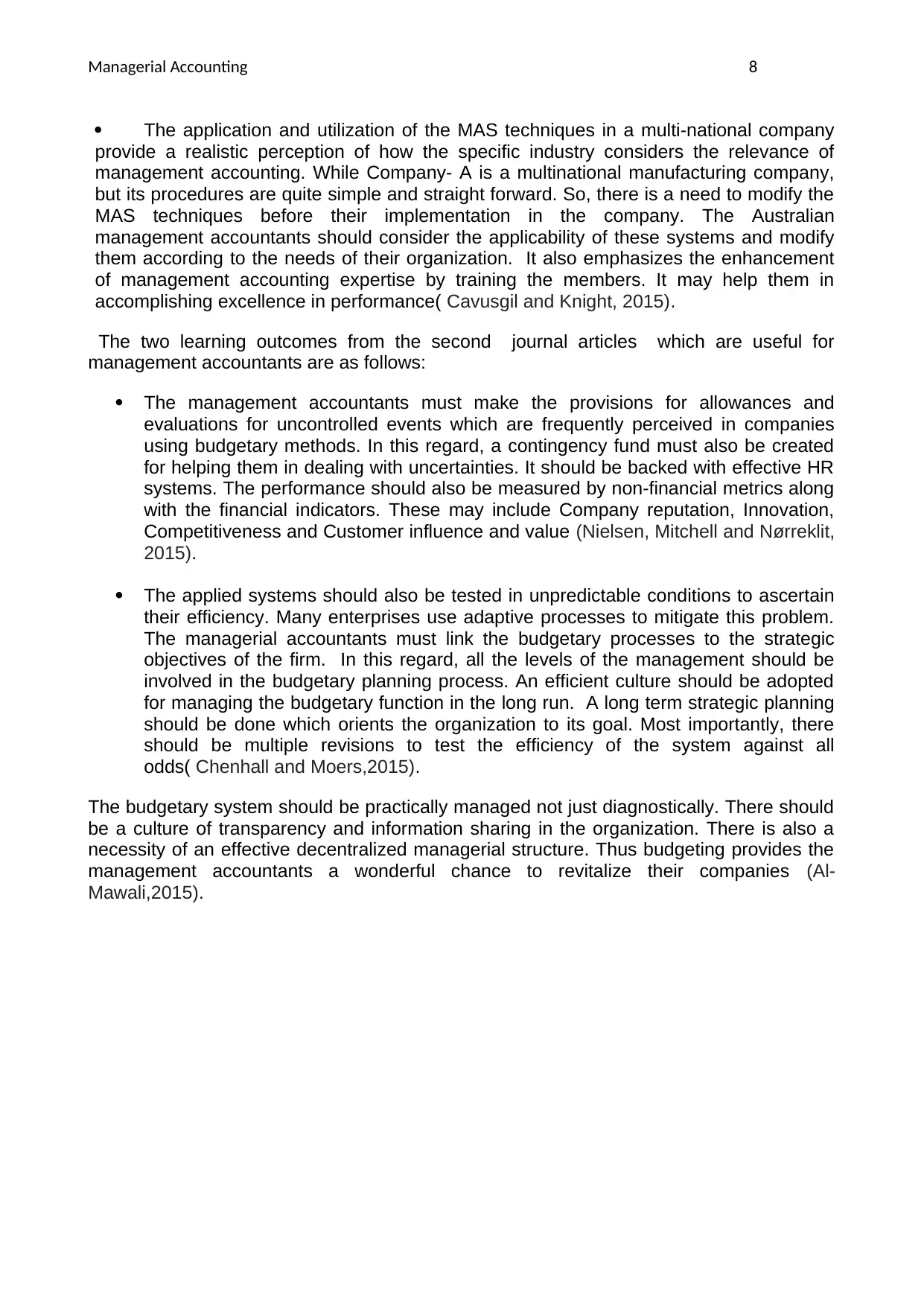
Managerial Accounting 8
The application and utilization of the MAS techniques in a multi-national company
provide a realistic perception of how the specific industry considers the relevance of
management accounting. While Company- A is a multinational manufacturing company,
but its procedures are quite simple and straight forward. So, there is a need to modify the
MAS techniques before their implementation in the company. The Australian
management accountants should consider the applicability of these systems and modify
them according to the needs of their organization. It also emphasizes the enhancement
of management accounting expertise by training the members. It may help them in
accomplishing excellence in performance( Cavusgil and Knight, 2015).
The two learning outcomes from the second journal articles which are useful for
management accountants are as follows:
The management accountants must make the provisions for allowances and
evaluations for uncontrolled events which are frequently perceived in companies
using budgetary methods. In this regard, a contingency fund must also be created
for helping them in dealing with uncertainties. It should be backed with effective HR
systems. The performance should also be measured by non-financial metrics along
with the financial indicators. These may include Company reputation, Innovation,
Competitiveness and Customer influence and value (Nielsen, Mitchell and Nørreklit,
2015).
The applied systems should also be tested in unpredictable conditions to ascertain
their efficiency. Many enterprises use adaptive processes to mitigate this problem.
The managerial accountants must link the budgetary processes to the strategic
objectives of the firm. In this regard, all the levels of the management should be
involved in the budgetary planning process. An efficient culture should be adopted
for managing the budgetary function in the long run. A long term strategic planning
should be done which orients the organization to its goal. Most importantly, there
should be multiple revisions to test the efficiency of the system against all
odds( Chenhall and Moers,2015).
The budgetary system should be practically managed not just diagnostically. There should
be a culture of transparency and information sharing in the organization. There is also a
necessity of an effective decentralized managerial structure. Thus budgeting provides the
management accountants a wonderful chance to revitalize their companies (Al-
Mawali,2015).
The application and utilization of the MAS techniques in a multi-national company
provide a realistic perception of how the specific industry considers the relevance of
management accounting. While Company- A is a multinational manufacturing company,
but its procedures are quite simple and straight forward. So, there is a need to modify the
MAS techniques before their implementation in the company. The Australian
management accountants should consider the applicability of these systems and modify
them according to the needs of their organization. It also emphasizes the enhancement
of management accounting expertise by training the members. It may help them in
accomplishing excellence in performance( Cavusgil and Knight, 2015).
The two learning outcomes from the second journal articles which are useful for
management accountants are as follows:
The management accountants must make the provisions for allowances and
evaluations for uncontrolled events which are frequently perceived in companies
using budgetary methods. In this regard, a contingency fund must also be created
for helping them in dealing with uncertainties. It should be backed with effective HR
systems. The performance should also be measured by non-financial metrics along
with the financial indicators. These may include Company reputation, Innovation,
Competitiveness and Customer influence and value (Nielsen, Mitchell and Nørreklit,
2015).
The applied systems should also be tested in unpredictable conditions to ascertain
their efficiency. Many enterprises use adaptive processes to mitigate this problem.
The managerial accountants must link the budgetary processes to the strategic
objectives of the firm. In this regard, all the levels of the management should be
involved in the budgetary planning process. An efficient culture should be adopted
for managing the budgetary function in the long run. A long term strategic planning
should be done which orients the organization to its goal. Most importantly, there
should be multiple revisions to test the efficiency of the system against all
odds( Chenhall and Moers,2015).
The budgetary system should be practically managed not just diagnostically. There should
be a culture of transparency and information sharing in the organization. There is also a
necessity of an effective decentralized managerial structure. Thus budgeting provides the
management accountants a wonderful chance to revitalize their companies (Al-
Mawali,2015).
⊘ This is a preview!⊘
Do you want full access?
Subscribe today to unlock all pages.

Trusted by 1+ million students worldwide
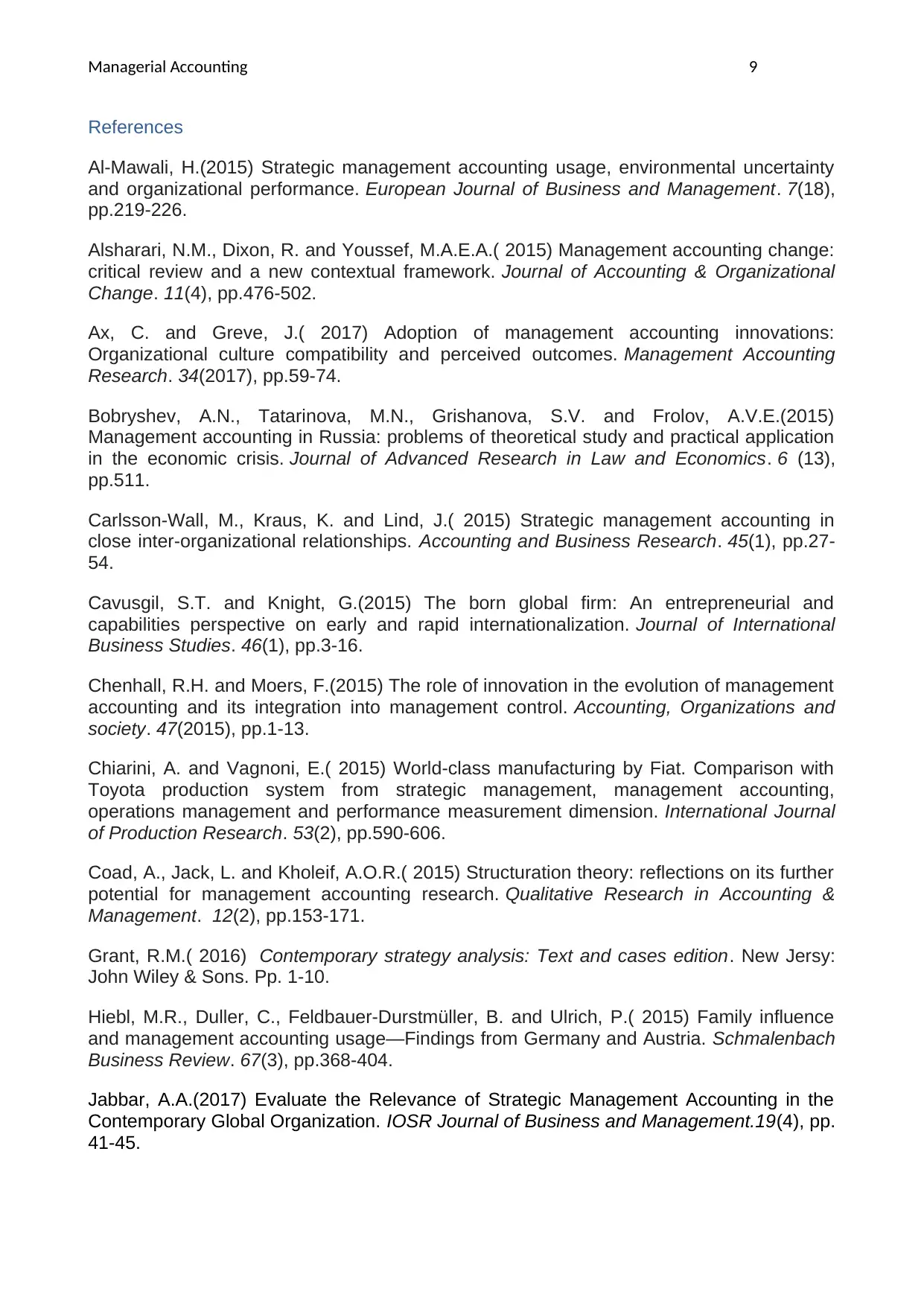
Managerial Accounting 9
References
Al-Mawali, H.(2015) Strategic management accounting usage, environmental uncertainty
and organizational performance. European Journal of Business and Management. 7(18),
pp.219-226.
Alsharari, N.M., Dixon, R. and Youssef, M.A.E.A.( 2015) Management accounting change:
critical review and a new contextual framework. Journal of Accounting & Organizational
Change. 11(4), pp.476-502.
Ax, C. and Greve, J.( 2017) Adoption of management accounting innovations:
Organizational culture compatibility and perceived outcomes. Management Accounting
Research. 34(2017), pp.59-74.
Bobryshev, A.N., Tatarinova, M.N., Grishanova, S.V. and Frolov, A.V.E.(2015)
Management accounting in Russia: problems of theoretical study and practical application
in the economic crisis. Journal of Advanced Research in Law and Economics. 6 (13),
pp.511.
Carlsson-Wall, M., Kraus, K. and Lind, J.( 2015) Strategic management accounting in
close inter-organizational relationships. Accounting and Business Research. 45(1), pp.27-
54.
Cavusgil, S.T. and Knight, G.(2015) The born global firm: An entrepreneurial and
capabilities perspective on early and rapid internationalization. Journal of International
Business Studies. 46(1), pp.3-16.
Chenhall, R.H. and Moers, F.(2015) The role of innovation in the evolution of management
accounting and its integration into management control. Accounting, Organizations and
society. 47(2015), pp.1-13.
Chiarini, A. and Vagnoni, E.( 2015) World-class manufacturing by Fiat. Comparison with
Toyota production system from strategic management, management accounting,
operations management and performance measurement dimension. International Journal
of Production Research. 53(2), pp.590-606.
Coad, A., Jack, L. and Kholeif, A.O.R.( 2015) Structuration theory: reflections on its further
potential for management accounting research. Qualitative Research in Accounting &
Management. 12(2), pp.153-171.
Grant, R.M.( 2016) Contemporary strategy analysis: Text and cases edition. New Jersy:
John Wiley & Sons. Pp. 1-10.
Hiebl, M.R., Duller, C., Feldbauer-Durstmüller, B. and Ulrich, P.( 2015) Family influence
and management accounting usage—Findings from Germany and Austria. Schmalenbach
Business Review. 67(3), pp.368-404.
Jabbar, A.A.(2017) Evaluate the Relevance of Strategic Management Accounting in the
Contemporary Global Organization. IOSR Journal of Business and Management.19(4), pp.
41-45.
References
Al-Mawali, H.(2015) Strategic management accounting usage, environmental uncertainty
and organizational performance. European Journal of Business and Management. 7(18),
pp.219-226.
Alsharari, N.M., Dixon, R. and Youssef, M.A.E.A.( 2015) Management accounting change:
critical review and a new contextual framework. Journal of Accounting & Organizational
Change. 11(4), pp.476-502.
Ax, C. and Greve, J.( 2017) Adoption of management accounting innovations:
Organizational culture compatibility and perceived outcomes. Management Accounting
Research. 34(2017), pp.59-74.
Bobryshev, A.N., Tatarinova, M.N., Grishanova, S.V. and Frolov, A.V.E.(2015)
Management accounting in Russia: problems of theoretical study and practical application
in the economic crisis. Journal of Advanced Research in Law and Economics. 6 (13),
pp.511.
Carlsson-Wall, M., Kraus, K. and Lind, J.( 2015) Strategic management accounting in
close inter-organizational relationships. Accounting and Business Research. 45(1), pp.27-
54.
Cavusgil, S.T. and Knight, G.(2015) The born global firm: An entrepreneurial and
capabilities perspective on early and rapid internationalization. Journal of International
Business Studies. 46(1), pp.3-16.
Chenhall, R.H. and Moers, F.(2015) The role of innovation in the evolution of management
accounting and its integration into management control. Accounting, Organizations and
society. 47(2015), pp.1-13.
Chiarini, A. and Vagnoni, E.( 2015) World-class manufacturing by Fiat. Comparison with
Toyota production system from strategic management, management accounting,
operations management and performance measurement dimension. International Journal
of Production Research. 53(2), pp.590-606.
Coad, A., Jack, L. and Kholeif, A.O.R.( 2015) Structuration theory: reflections on its further
potential for management accounting research. Qualitative Research in Accounting &
Management. 12(2), pp.153-171.
Grant, R.M.( 2016) Contemporary strategy analysis: Text and cases edition. New Jersy:
John Wiley & Sons. Pp. 1-10.
Hiebl, M.R., Duller, C., Feldbauer-Durstmüller, B. and Ulrich, P.( 2015) Family influence
and management accounting usage—Findings from Germany and Austria. Schmalenbach
Business Review. 67(3), pp.368-404.
Jabbar, A.A.(2017) Evaluate the Relevance of Strategic Management Accounting in the
Contemporary Global Organization. IOSR Journal of Business and Management.19(4), pp.
41-45.
Paraphrase This Document
Need a fresh take? Get an instant paraphrase of this document with our AI Paraphraser
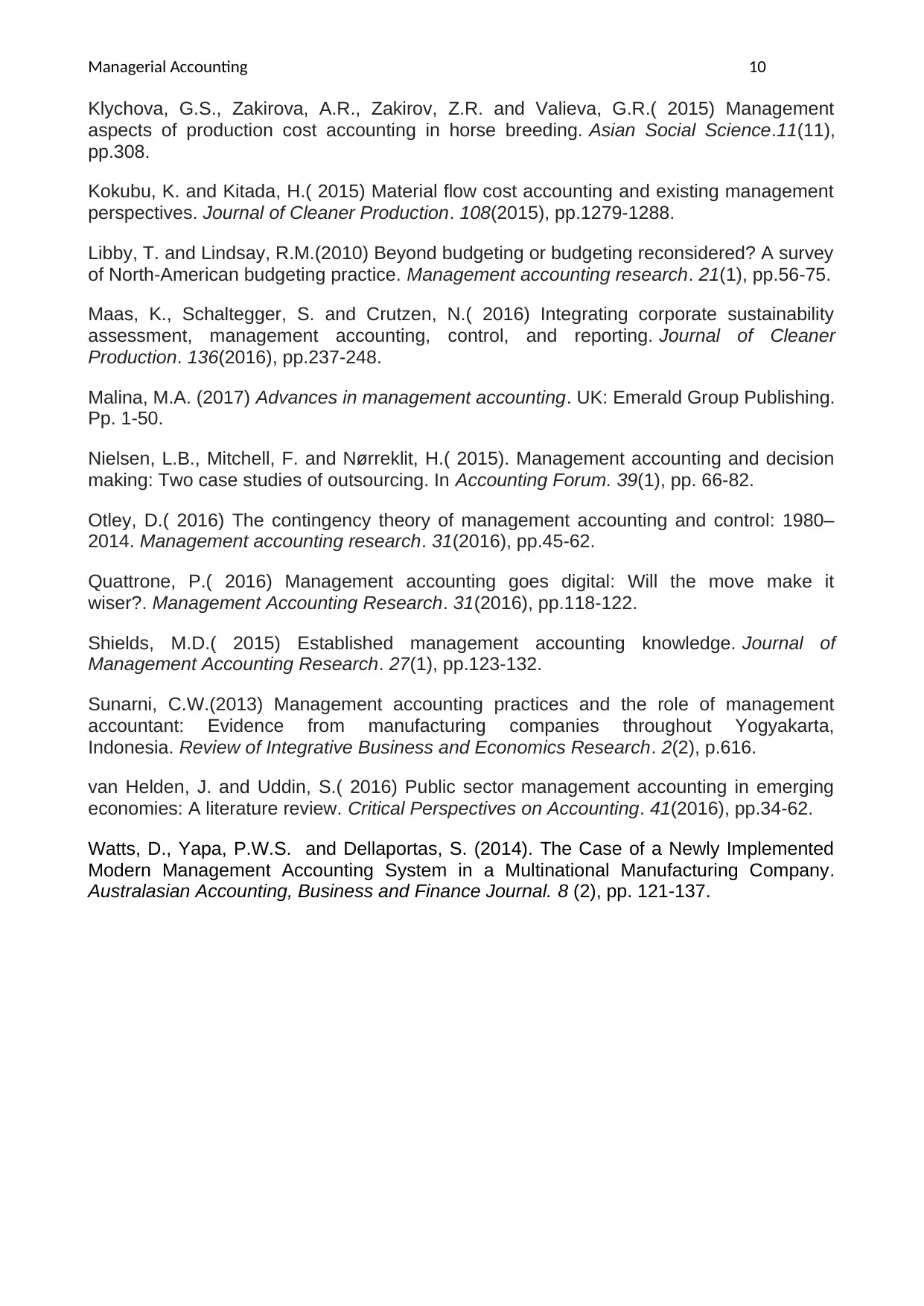
Managerial Accounting 10
Klychova, G.S., Zakirova, A.R., Zakirov, Z.R. and Valieva, G.R.( 2015) Management
aspects of production cost accounting in horse breeding. Asian Social Science.11(11),
pp.308.
Kokubu, K. and Kitada, H.( 2015) Material flow cost accounting and existing management
perspectives. Journal of Cleaner Production. 108(2015), pp.1279-1288.
Libby, T. and Lindsay, R.M.(2010) Beyond budgeting or budgeting reconsidered? A survey
of North-American budgeting practice. Management accounting research. 21(1), pp.56-75.
Maas, K., Schaltegger, S. and Crutzen, N.( 2016) Integrating corporate sustainability
assessment, management accounting, control, and reporting. Journal of Cleaner
Production. 136(2016), pp.237-248.
Malina, M.A. (2017) Advances in management accounting. UK: Emerald Group Publishing.
Pp. 1-50.
Nielsen, L.B., Mitchell, F. and Nørreklit, H.( 2015). Management accounting and decision
making: Two case studies of outsourcing. In Accounting Forum. 39(1), pp. 66-82.
Otley, D.( 2016) The contingency theory of management accounting and control: 1980–
2014. Management accounting research. 31(2016), pp.45-62.
Quattrone, P.( 2016) Management accounting goes digital: Will the move make it
wiser?. Management Accounting Research. 31(2016), pp.118-122.
Shields, M.D.( 2015) Established management accounting knowledge. Journal of
Management Accounting Research. 27(1), pp.123-132.
Sunarni, C.W.(2013) Management accounting practices and the role of management
accountant: Evidence from manufacturing companies throughout Yogyakarta,
Indonesia. Review of Integrative Business and Economics Research. 2(2), p.616.
van Helden, J. and Uddin, S.( 2016) Public sector management accounting in emerging
economies: A literature review. Critical Perspectives on Accounting. 41(2016), pp.34-62.
Watts, D., Yapa, P.W.S. and Dellaportas, S. (2014). The Case of a Newly Implemented
Modern Management Accounting System in a Multinational Manufacturing Company.
Australasian Accounting, Business and Finance Journal. 8 (2), pp. 121-137.
Klychova, G.S., Zakirova, A.R., Zakirov, Z.R. and Valieva, G.R.( 2015) Management
aspects of production cost accounting in horse breeding. Asian Social Science.11(11),
pp.308.
Kokubu, K. and Kitada, H.( 2015) Material flow cost accounting and existing management
perspectives. Journal of Cleaner Production. 108(2015), pp.1279-1288.
Libby, T. and Lindsay, R.M.(2010) Beyond budgeting or budgeting reconsidered? A survey
of North-American budgeting practice. Management accounting research. 21(1), pp.56-75.
Maas, K., Schaltegger, S. and Crutzen, N.( 2016) Integrating corporate sustainability
assessment, management accounting, control, and reporting. Journal of Cleaner
Production. 136(2016), pp.237-248.
Malina, M.A. (2017) Advances in management accounting. UK: Emerald Group Publishing.
Pp. 1-50.
Nielsen, L.B., Mitchell, F. and Nørreklit, H.( 2015). Management accounting and decision
making: Two case studies of outsourcing. In Accounting Forum. 39(1), pp. 66-82.
Otley, D.( 2016) The contingency theory of management accounting and control: 1980–
2014. Management accounting research. 31(2016), pp.45-62.
Quattrone, P.( 2016) Management accounting goes digital: Will the move make it
wiser?. Management Accounting Research. 31(2016), pp.118-122.
Shields, M.D.( 2015) Established management accounting knowledge. Journal of
Management Accounting Research. 27(1), pp.123-132.
Sunarni, C.W.(2013) Management accounting practices and the role of management
accountant: Evidence from manufacturing companies throughout Yogyakarta,
Indonesia. Review of Integrative Business and Economics Research. 2(2), p.616.
van Helden, J. and Uddin, S.( 2016) Public sector management accounting in emerging
economies: A literature review. Critical Perspectives on Accounting. 41(2016), pp.34-62.
Watts, D., Yapa, P.W.S. and Dellaportas, S. (2014). The Case of a Newly Implemented
Modern Management Accounting System in a Multinational Manufacturing Company.
Australasian Accounting, Business and Finance Journal. 8 (2), pp. 121-137.
1 out of 11
Related Documents
Your All-in-One AI-Powered Toolkit for Academic Success.
+13062052269
info@desklib.com
Available 24*7 on WhatsApp / Email
![[object Object]](/_next/static/media/star-bottom.7253800d.svg)
Unlock your academic potential
Copyright © 2020–2025 A2Z Services. All Rights Reserved. Developed and managed by ZUCOL.





